In our previous lessons, we covered how to build your B2B lead list using the target account’s website and how to do more than just networking on LinkedIn for lead generation.
But now that you have a lead list, it’s time to reach out to them and that’s why this lesson covers how to write emails that convert.
This is Lesson 4 from our FindThatLead Bible – Growth hacking your first 1000 customers. We’re simplifying how you generate your lead list and convert them with this extensive guide. Subscribe to our blog to be notified of every new lesson.
Let’s face it, B2B cold emailing is hard.
You’re always half a step away from either sounding too salty or too vague.
What makes it more challenging is how the modern consumer’s inbox has become a fiercely competitive space. Actually, what we call it is ‘noisy’.
But that doesn’t mean you can’t succeed at B2B cold emailing. After all, Sean Bestor used 5 simple cold email templates to grow Sumo to $5 million.
So what makes one B2B cold outreach email differ so much from all the others that marketers and salespeople keep bombarding your target accounts with?
Well, we dug deep into the strategy that Sumo followed and combined it with the learnings we have had from our own campaigns.
Here’s what we learned about writing a crafty email that adds value to your leads and at the same time, gets you successful conversions too!
Tips to write B2B cold emails that convert
1. Write catchy subject lines
The average office worker can get over 120 emails a day. And everybody is offering them something. You included. In an inbox full of newsletters and updates, which is the first email you open? The one with a subject line that instantly captures your attention.
Strong email subject lines are the first step to making your B2B cold emails effective.
But creating that catchy subject line itself can be a challenging task. While you want it to capture attention immediately, you also want to make sure that it is relevant to what you’re saying inside and is not spammy either.
A few best practices that we follow at FindThatLead, include:
- Writing shorter email subject lines
- Tap into the target account’s interest
- Generate curiosity in what you have to offer. Tease curiosity… Writing “meeting at 10?” is better than “are you willing to have a chat tomorrow at where we could talk about the demo…”
- Personalize with the available data
2. Keep it short and sweet (and absolutely clear)
Brevity is key to cold emailing. A lot many times we think that explaining what we’re reaching out for equals having to use a lot of words. But that’s exactly what you should not be doing in an email!
Boomerang analyzed 40 million emails and found that those using only 50 to 100 words received a higher response rate. The reason being that the message was able to convey its value proposition faster.
When you’re writing out the email, think if you would have the time to read it. Make sure it’s something you can read even on a busy day.
So keeping your message concise and clear is the trick to ensuring your message is getting read and understood.
Pro tip: Use short sentences and paragraphs to increase readability.
3. Personalize by using an account-based marketing approach
Don’t address your B2B leads with generic sales messages. Use all the research you did while creating your B2B lead list to personalize how you reach out to target accounts.
This does two things in a B2B cold email.
🔵One, it gives your email a personality instead of sounding like an automated robot. Avoid using things like “dear, customer” and instead star using “Hi, [name]”.
🔵Second, it makes the message super relevant to the recipient – right from the terms used, challenges addressed, solutions offered and the links included.
Both combined together is the secret recipe to capturing the recipient’s attention and nudging them towards making an interaction.
But even in an account-based marketing approach to cold emailing, try using the following formulae in your campaign:
- The ‘right contact’ approach – Simply tell the recipient why you’re reaching out to them and if they’re the right person to talk to about your solution.
- The ‘problem-focused’ approach – Capture the recipient’s attention by highlighting the problem they’re facing and then plugging in the solution you’re offering.
- The ‘we know you’ Approach – Find out something about the target account – how they’re running processes or the solution they’re using. Then reach out to them highlighting you noticed the same thing and have something better to offer. You can even find a blog comment, a LinkedIn post or even a hobby and then weave it into your B2B cold email template.
- The ‘curiosity’ approach – Identify an interesting fact about the industry your target account is in and use the first line to present it. Hook them with curiosity before presenting your solution.
Also, a good recommendation here would be to use short paragraphs and sentences. People usually scan content when reading, only focusing on informations that’s useful and relevant for them. To make your content easier, stick to 2-3 simple sentence paragraphs.
4. Include a simple, single call-to-action
It’s obvious that when you get a chance, you want to make the most of it. You might want to introduce every aspect of your product/ service in the first email itself.
But that’s where you lose the chance to convert this lead. If you present a lead with too many options, you’ll only end up overwhelming them – it is called the paradox of choice.
That’s why you should focus on drilling down your message to one point at a time and present them with a single, clear call to action.
If you want them to book a demo, state that clearly in your email. If you want them to read a recent blog post you wrote that they might relate to, simply link to it – don’t ask them to do anything else.
5. Experiment with GIFs and emojis (stand out!)
Everyone’s sending text emails. Everyone’s also including a few screenshots and PDFs of their products. What can you do differently?

Well, if you use Buffer, you might have seen them include GIFs in their emails – be it their outreach emails, nurture emails or update emails. That little experiment they did years ago has become something that reflects the personality of their company and its team members.
The same goes with Zest.is too. They use a mix of text and GIFs to get their message across in an engaging way.
Use the same psychology in your B2B cold emails.
Adding a little humor or interactive content like GIFs and emojis makes you sound a little more ‘human’ and authentic. And that’s one growth hack we’ve always sworn by! It will also enhance the personality and warmth conveyed in your cold emails.
6. Use an impressive email signature
More often than not, companies don’t have a consistent email signature for all their employees – marketers and salespeople included.
Now imagine meeting someone at Starbucks, having an entire conversation with them, and walking away only to realize you don’t remember their name. While you might remember bits and pieces of the discussion you had, where they came from and what they do is somewhat a blur – that’s because they didn’t hand over a card or anything to you while parting ways.
The same holds true with B2B cold emails. You need to leave a powerful mark on the recipient and it’s not all that difficult!
You can create an impressive email signature using the FindThatLead Signature generator, in minutes.
- Go to FindThatLead Signature Generator and choose a template for your signature – don’t worry, you can customize it as much as you like later.
- Now fill out your personal details like name, phone number, website, email address, social media profiles, etc.
- Upload your company logo and a picture of yourself for the recipient to relate with. You can also adjust the image width here.
- Customize your email signature by changing the template color, text color, font, font size, and more.
- Lastly, add a call-to-action text and a URL you want the recipient to click on.
- Once you’re done, click on ‘I want this signature and you’re done!
Ps. Remember to ask your team to use the same email signature style to reinforce your brand image and improve brand recall – no matter what stage a lead is at.
7. Proofread twice before you hit send
One of the most common mistakes we have made (and seen), is not proofreading what we write. Sometimes, we get so carried away while writing a message that it all makes sense to us then – and reads well too.
But that’s often not the case.
We suggest writing out your B2B cold email separately first. Fact-check the name of the person you’re reaching out to, their job role, the company name, spelling mistakes or even grammatical errors that may have gotten typed out.
💙Pro tip: Use Grammarly to ensure you’ve framed your email content right!
8. Include timely follow-ups in your B2B cold email strategy
After speaking with a lot of marketers and salespeople we found that many didn’t have a systematic approach in place to follow up the leads.
Imagine being promoted a new range of food products without being followed up with more information on them. Would you consume these products?
Absolutely not!
The same holds true in the B2B industry. You have to nurture your leads by offering them more information that adds value to them and helps them make an informed decision.
Instead of relying on manual efforts to follow up on your leads, build a solid email campaign on a tool like Email Sender by FindThatLead.
With the email sender, you can walk your leads from the point of first outreach, through your entire sales journey without being too pushy. At the same time, you also get to ensure lesser leaks with timely follow-ups!
Just some examples you can take into account…
1. B2B Cold Email Template 1: AIDA Formula
- Attention: hooks lead attention.
- Interest: in order to get them engaged, relate to their interest.
- Action: ask them to do something from your mail (either click, reply or purchase)
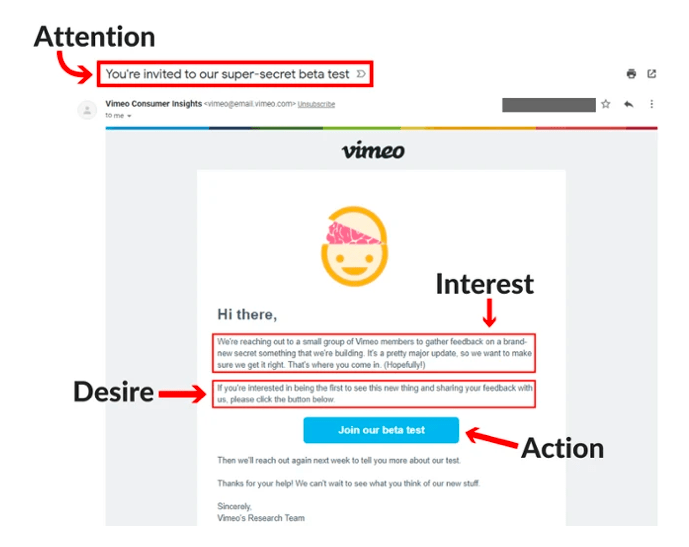
2. B2B Cold Email Template 2: the BAB formula
- Before: describe the issue the lead is facing.
- After: show them how the situation looks like when the problem is solved.
- Bridge: show how your service if going to help them get to that desired situation.
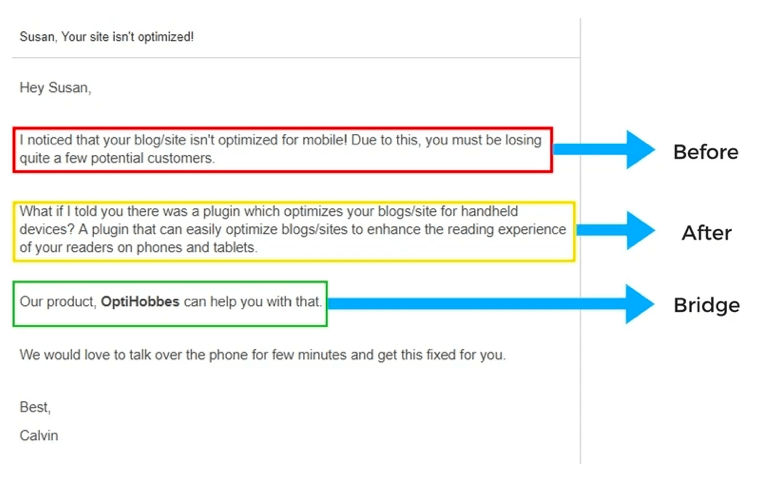
3. B2B Cold Email Template 3: the PAS formula.
- Problem: highlight the issue that causes them frustration.
- Agitate: explain its consequences.
- Solution: offer a way to remove the pain caused by the problem.
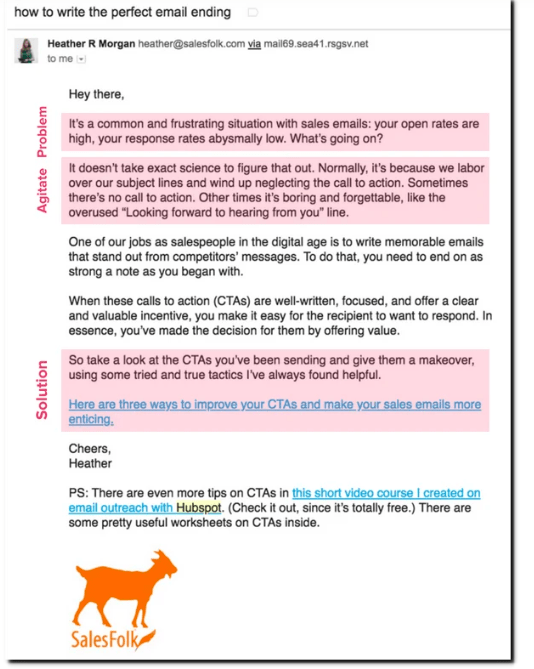
Setting up a crafty email is not enough!
You have your B2B lead list in place. You’ve also created a perfect outreach email and set it up on your email marketing tool.
But does your job end there? NO.
If you want to increase the conversions on your B2B cold email campaigns, you need to continually measure the performance of your emails and optimize your approach.
That’s why, in the next lesson, we’re sharing How to measure and optimize your B2B lead generation efforts.

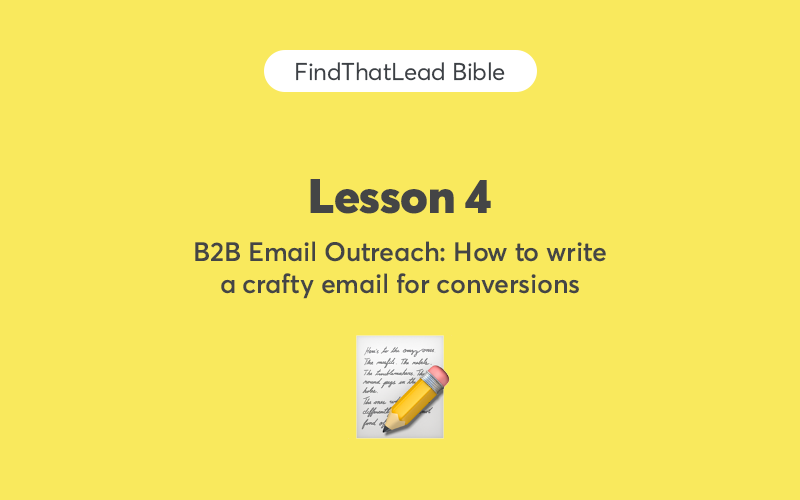

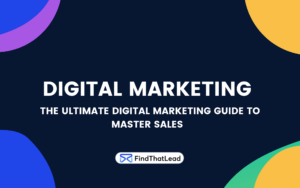
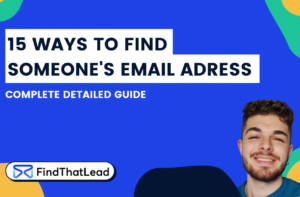


 BONUS:
BONUS: The Challenge: Join this free course and I guarantee that after 5 days you will have the necessary skills to start generating B2B clients Growth Hacking and Prospecting techniques.
The Challenge: Join this free course and I guarantee that after 5 days you will have the necessary skills to start generating B2B clients Growth Hacking and Prospecting techniques.